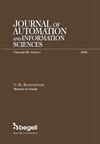APPROXIMATION OF FUNCTIONS BY GAUSS-WEIERSTRASS INTEGRALS
Q3 Engineering
Journal of Automation and Information Sciences
Pub Date : 2021-03-01
DOI:10.34229/1028-0979-2021-2-10
引用次数: 0
Abstract
When considering various schemes and algorithms for game problems of dynamics, researchers often have to deal with solutions of partial differential equations. A special place among the latter is occupied by the so-called equations of elliptic type (according to the corresponding classification), with the help of which natural and social processes can be described most fully and qualitatively. Moreover, the mathematical apparatus of partial differential equations of elliptic type makes it possible to get into the environment of deterministic phenomena and thus makes it possible to foresee their future. This fact undoubtedly increases the significance of the above type of equations among others in the sense of their application to mathematical modeling. At the same time, one of the most important concepts in applied mathematics is the concept of the modulus of continuity. The term "modulus of continuity" and its definition were introduced by Henri Lebesgue at the beginning of the last century in order to study various properties of continuous functions. Using the concept of the modulus of continuity and its properties, it is possible to investigate the belonging of the object under study to a certain class of functions: Hölder, Lipschitz, Zygmund, etc. This undoubtedly makes it possible to approximate functions of various kinds of operators most effectively. In this paper, using the example of the Gauss-Weierstrass integral as a solution to the corresponding differential equation of elliptic type, we study its rate of convergence in terms of the modulus of continuity of the second order to the function by which it was actually constructed. Namely, the boundary properties of the Gauss-Weierstrass integral were studied as a linear positive operator that realizes its best approximation on functions from the Zygmund class. The results obtained in this article can further be used to solve many problems in applied mathematics.函数的GAUSS-WEIERSTRASS积分逼近
在考虑动力学博弈问题的各种方案和算法时,研究人员经常要处理偏微分方程的解。后者中的一个特殊位置是所谓的椭圆型方程(根据相应的分类),借助于它可以最全面、最定性地描述自然和社会过程。此外,椭圆型偏微分方程的数学装置使我们有可能进入确定性现象的环境,从而有可能预见它们的未来。这一事实无疑增加了上述类型方程在数学建模中的应用意义。同时,应用数学中最重要的概念之一是连续模的概念。Henri Lebesgue在上世纪初提出了“连续模”一词及其定义,目的是研究连续函数的各种性质。利用连续模的概念及其性质,可以研究被研究对象对某类函数的归属:Hölder、Lipschitz、Zygmund等。这无疑使最有效地逼近各种算子的函数成为可能。本文以高斯-魏尔斯特拉斯积分为例,求解相应的椭圆型微分方程,用实际构造它的函数的二阶连续模来研究它的收敛速度。也就是说,高斯-魏尔斯特拉斯积分的边界性质被研究为一个线性正算子,它实现了对Zygmund类函数的最佳逼近。本文的结果可以进一步用于解决应用数学中的许多问题。
本文章由计算机程序翻译,如有差异,请以英文原文为准。
求助全文
约1分钟内获得全文
求助全文
来源期刊

Journal of Automation and Information Sciences
AUTOMATION & CONTROL SYSTEMS-
自引率
0.00%
发文量
0
审稿时长
6-12 weeks
期刊介绍:
This journal contains translations of papers from the Russian-language bimonthly "Mezhdunarodnyi nauchno-tekhnicheskiy zhurnal "Problemy upravleniya i informatiki". Subjects covered include information sciences such as pattern recognition, forecasting, identification and evaluation of complex systems, information security, fault diagnosis and reliability. In addition, the journal also deals with such automation subjects as adaptive, stochastic and optimal control, control and identification under uncertainty, robotics, and applications of user-friendly computers in management of economic, industrial, biological, and medical systems. The Journal of Automation and Information Sciences will appeal to professionals in control systems, communications, computers, engineering in biology and medicine, instrumentation and measurement, and those interested in the social implications of technology.
 求助内容:
求助内容: 应助结果提醒方式:
应助结果提醒方式:


